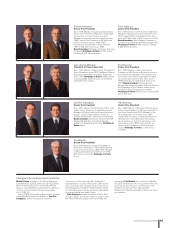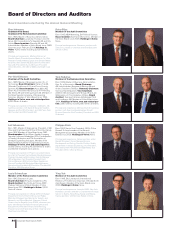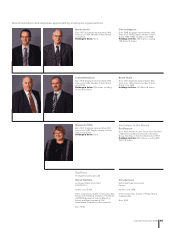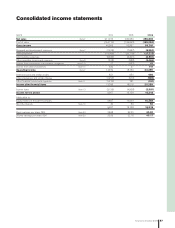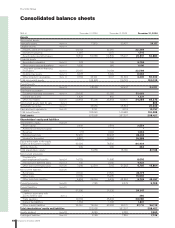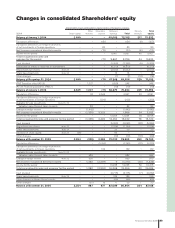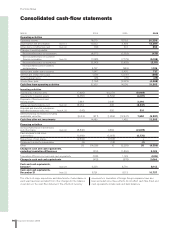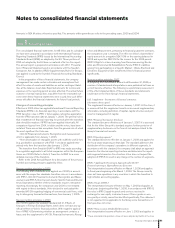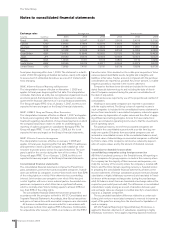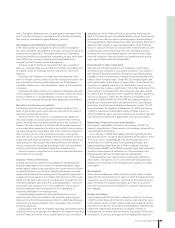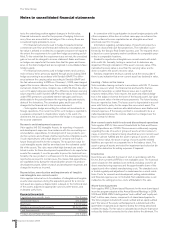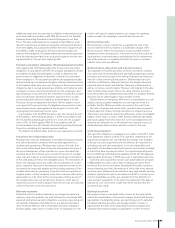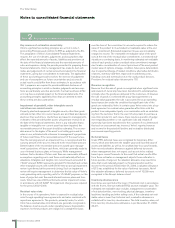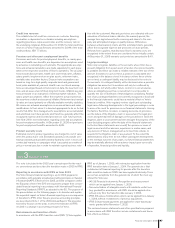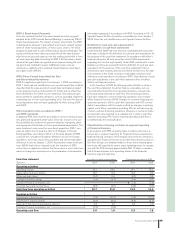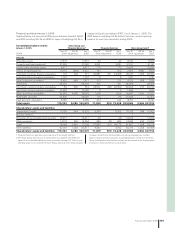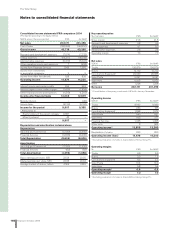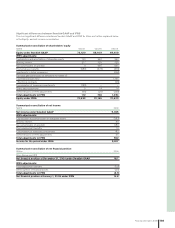Volvo 2006 Annual Report Download - page 97
Download and view the complete annual report
Please find page 97 of the 2006 Volvo annual report below. You can navigate through the pages in the report by either clicking on the pages listed below, or by using the keyword search tool below to find specific information within the annual report.
value. Translation differences are charged against earnings for the
year. Currently, Volvo has no subsidiaries with a functional currency
that could be considered a hyperinfl ationary currency.
Receivables and liabilities in foreign currency
In the individual Group companies as well as in the consolidated
accounts, receivables and liabilities in foreign currency are valued at
period-end exchange rates. Translation differences on operating
assets and liabilities are recognized in operating income, while trans-
lation differences arising in fi nancial assets and liabilities are
charged to other fi n ancial income and expenses.
Currency swap contracts are reported at fair value, unrealized
gains on exchange rates are reported as short term receivables and
unrealized losses on exchange rates are reported as short term
l iabilities.
Exchange rate differences on loans and other fi n ancial instru-
ments in foreign currency, which are used to hedge net assets in for-
eign subsidiaries and associated companies, are offset against
translation differences in the shareholders’ equity of the respective
companies.
Exchange rate gains and losses on payments during the year and
on the valuation of assets and liabilities in foreign currencies at year-
end are credited to, or charged against, income in the year they
arise. The more important exchange rates applied are shown above.
Net sales and revenue recognition
The Group’s reported net sales pertain mainly to revenues from
sales of goods and services. Net sales are reduced by the value of
discounts granted and by returns.
Income from the sale of goods is recognized when signifi cant
risks and rewards of ownership have been transferred to external
parties, normally when the goods are delivered to the customers. If,
however, the sale of goods is combined with a buy-back agreement
or a residual value guarantee, the sale is accounted for as an operat-
ing lease transaction if signifi cant risks of the goods are retained in
Volvo. Income from the sale of workshop services is recognized
when the service is provided. Rental revenues and interest income in
conjunction with fi n ancial leasing or installment contracts are recog-
nized during the underlying contract period. Revenue for mainte-
nance contracts are recognized according to how costs associated
with the contracts are distributed during the contract period.
Interest income is recognized on a continuous basis and dividend
income when it is received.
Leasing – Volvo as the lessor
Leasing contracts are defi ned in two categories, operational and
fi n a ncial, depending on the contract’s fi n ancial implications. Oper-
ational leasing contracts are reported as non-current assets in Assets
in operational leases. Income from operational leasing is reported
equally distributed over the leasing period. Straight-line depreciation
is applied to these assets in accordance with the terms of the under-
taking and the deprecation amount is adjusted to correspond to the
estimated realizable value when the undertaking expires. Assessed
impairments are charged in the income statement. The product’s
assessed realizable value at expiration of the undertaking is
reviewed continually on an individual basis.
Financial leasing agreements are reported as Non-current
respective Short-term receivables in the customer fi n ancing oper-
ations. Income from fi nancial leasing contracts is distributed between
interest income and amortization of the receivable in the customer
fi n a ncing operations.
In accordance with IAS 14, Segment reporting, operational leasing
contracts should be reclassifi ed to fi nancial in the segment reporting
of Volvo Financial Services if the residual value in these contracts is
guaranteed to Volvo Financial Services by another Volvo business
area. In the Volvo Group’s consolidated balance sheet, these leasing
agreements are still reported as operating leases. Reclassifi cation
from operational to fi nancial leasing contract also affects the income
statement with regards to sales and depreciation. Volvo Financial
Service’s sales are reduced as a result of the reclassifi cation as well
as depreciation, which affect cash fl ow from operating activities.
However, the Volvo consolidated balance sheet and income state-
ment still recognizes leasing contracts as operational and, accord-
ingly, reports higher sales and depreciation.
Investments in other companies
Volvo accounts for all investments in companies, except if these
investments are classifi ed as associated companies in accordance
with IAS 39, Financial Instruments: Recognition and Measurement.
Companies listed on a fi nancial exchange should be reported in the
balance sheet to market value. Under IAS 39, unrealized gains and
losses attributable to the change in market value of investments are
reported in a separate component of shareholders’ equity except
when the decline in value is signifi cant or other than temporary. If the
value decline is considered other than temporary, the value should
be written down through the income statement. IAS 39 is applied by
Volvo as of January 1, 2005 and the difference in valuation com-
pared with Swedish GAAP and the 2004 accounting principles is
that all such investments have been carried at their cost of acquisi-
tion unless there has been a permanent decrease in value. The dif-
ference between the valuation at December 31, 2004 and January
1, 2005 is reported in shareholders’ equity. Unlisted shares, for
which a reliable fair value can not be determined, should be reported
at a historical cost reduced in appropriate cases by write-downs.
Reporting of fi nancial assets and liabilities
Volvo reports marketable securities in accordance with IAS 39
based on classifi cation of these assets into a category valued at fair
value through profi t and loss.
As of January 1, 2005, Volvo applies IAS 39, regarding the time
that fi n ancial assets should be derecognized from the balance sheet.
This occurs when substantially all risks and rewards have been
transferred to an external party. Corresponding principles are
applied regarding fi n ancial assets in Volvo’s segment reporting.
Under Swedish GAAP, for the 2004 comparison year, fi n ancial assets
should be derecognized at settlement or if the ownership of the
fi n a ncial assets had been transferred to an external party.
Financial liabilities are reported at historical value reduced by
amortization. Transaction cost in connection with raising fi nancial
l iabilities are amortized over the fi n ancial loan’s duration as a fi n an-
cial expense.
Receivables
Accounts receivables are initially recognized at fair value, normally
equal with the nominal amount. In cases in which the payment terms
exceed one year, the receivable is carried at its discounted present
value. Provisions for doubtful receivables are made on a current
basis after an assessment of whether the customer’s ability to pay
has changed.
Hedge accounting
In accordance with IAS 39, which is applied by Volvo as of January
1, 2005, certain fi n ancial instruments shall be reported at fair value
in the balance sheet. In order to apply hedge accounting, the follow-
ing criteria must be met: the position being hedged is identifi ed and
exposed to market value movements, for instance related to
exchange-rate or interest-rate movements, the purpose of the loan/
instrument is to serve as a hedge and the hedging effectively pro-
Financial information 2006 93


